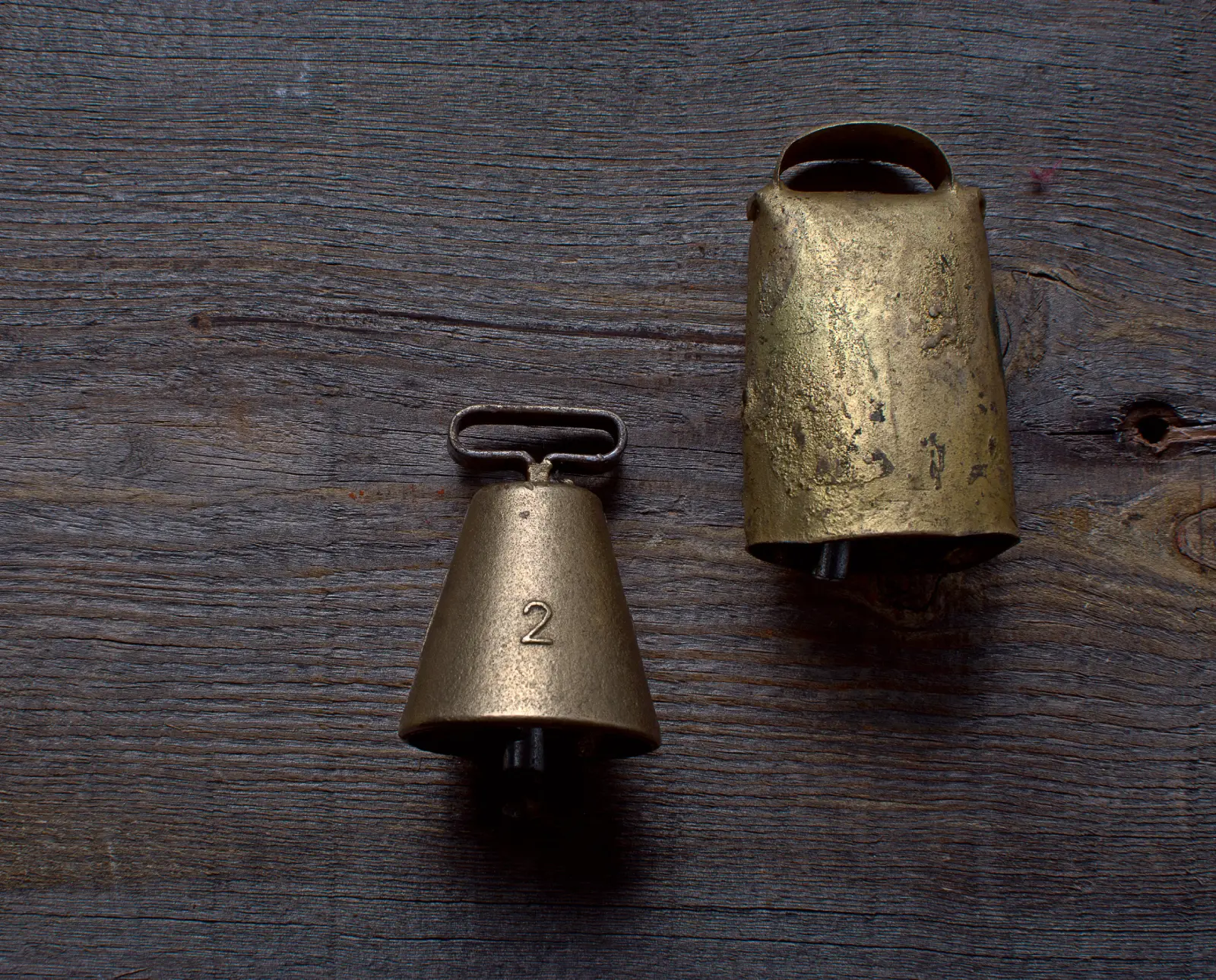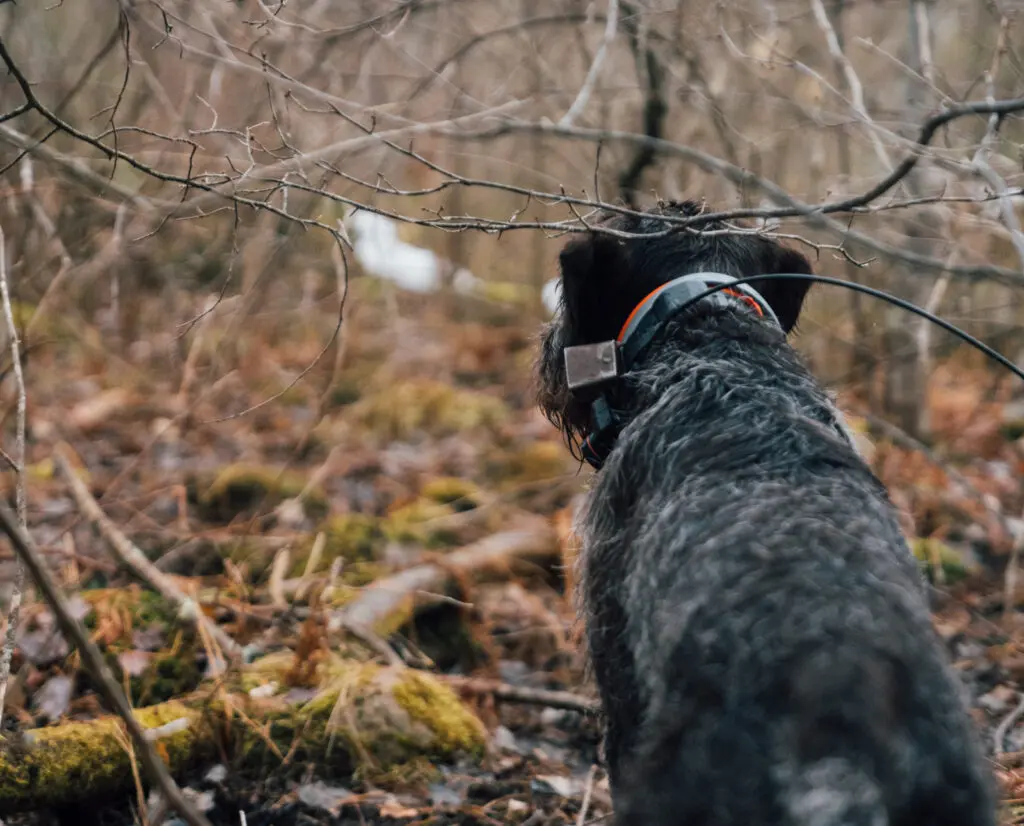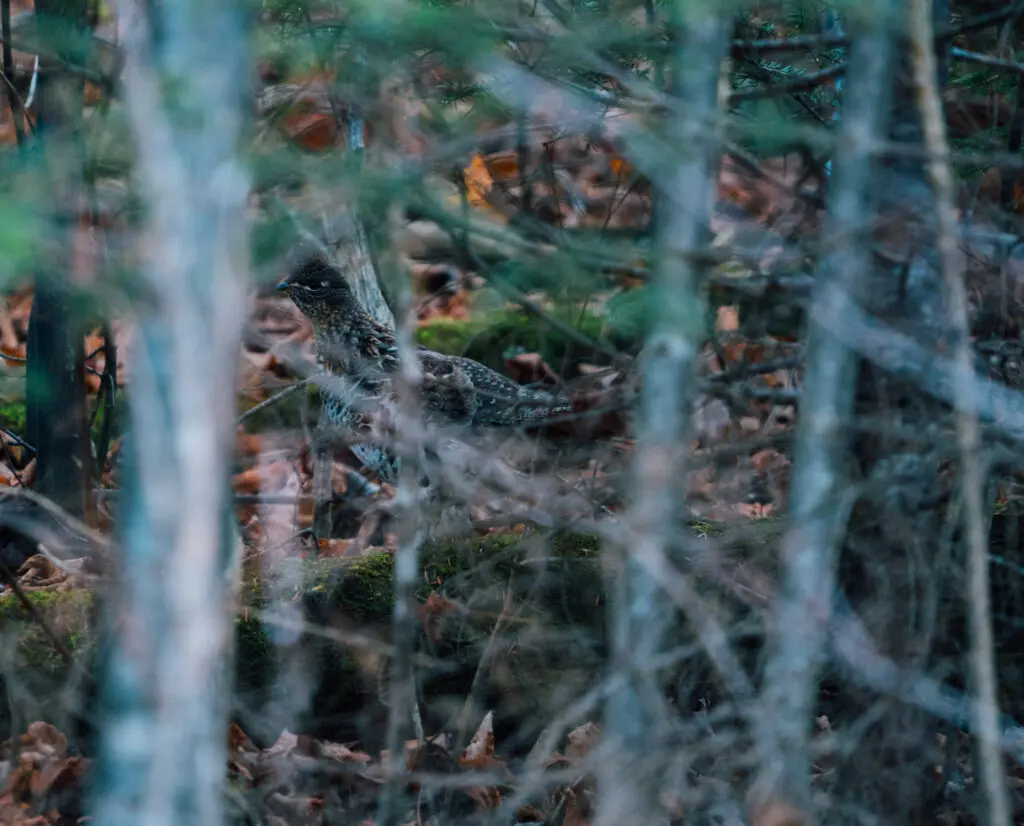Home » Grouse Species » Ruffed Grouse Hunting » Are Dog Bells a Hindrance in Ruffed Grouse Hunting?
Are Dog Bells a Hindrance in Ruffed Grouse Hunting?

A.J. DeRosa, founder of Project Upland, is a New England…
Weighing the impact of dog bells on Ruffed Grouse hunting tactics and success.
With every step, my black snow pants swished as I trailed behind my father, brother, and a Brittany while we hunted ruffed grouse in October of 1987. The forest ambiance was punctuated by the calls of blue jays and crows. Leaves crunched underfoot. They reminded me of potato chips, almost heralding an upcoming Halloween party. Occasionally, the echo of a shotgun blast shattered the crisp air. These jaunts through the woods were as enchanting as the sight of pumpkins glowing faintly across the neighborhood during our silent walks home each evening.
Listen to more articles on Apple | Google | Spotify | Audible
Reflecting on the sounds of a New England grouse cover always brings me joy. One might try to paint a scene akin to a Ripley painting using these senses, but I find myself drawn to the language of silence. Recently, I discovered my father’s annoyance with the swishing sound of my pants. “We are scaring all the birds away,” he’d say when I wasn’t near, sparing my childhood daydreams of adventure.
My father never used bells on his dogs. I never dwelled on it much, often attributing his decisions to the solitary way he embraced mentorless ruffed grouse hunting. He didn’t have friends who shared the pursuit with pointing dogs, and my grandfather, a deer hunter, saw it as a poor return on energy investment. Yet, my father’s dedication carved a path I couldn’t have foreseen. Watching my brother effortlessly shoot ruffed grouse in flight, I felt overshadowed. But those subtle, unspoken lessons provided just the right touch of guidance, pushing me to try harder.
Certain distinct sounds easily transport me back to a past fall. Over time, even the dog bell, iconic in its own right, has come to evoke the essence of autumn for me. It’s emblematic of those hunting in the dense grouse habitats of North America. However, I’ve often left the bell at home, realizing that ruffed grouse are clever enough to discern exactly what that bell signifies.
Birds primarily rely on sight and sound to evade predators. We know that ruffed grouse are far more jumpy in high winds because their hearing is impaired. Living in dense cover has heightened their dependence on sound. In my opinion, their sense of hearing is often greater than sight. When we factor in transgenerational stress inheritance, we gain insight into sound’s profound impact on ruffed grouse hunting.
No matter how good the dog’s work may be, its bell’s jingle alerts grouse. The birds understand the threat, beginning evasive movements well before a dog has a chance to catch scent. Between scenting conditions, bird locations, and weather, a million variables stack up against us in unknown ways. These odds are daunting enough to dissuade us from adding another variable that would put a dog at an inherent disadvantage. However, the efficiency of killing is far from the pinnacle of the true love of grouse hunting, and interpreting the language of a dog bell is often part of that joy.
Bells, talking, and walking through cover all impact grouse well before contacts are made. This is no new theory, and while I have experimented in recent years by leaving the dog bell in the truck, one can go back as far as the late 1800s to read from our forefathers on the topic of grouse and sound.

The History of the Dog Bell
“It has fallen to the lot of comparatively few to witness this very striking performance, as our wary bird at this time is peculiarly susceptible to the slightest noise,” said S. T. Hammond in My Friend The Partridge: Memories of New England Shooting in 1908. “At the least suspicion of intruding footsteps he at once takes to flight or skulks away through the convenient thicket.”
The history of upland hunting in dense covers is deeply rooted in New England traditions. Among the most prominent equipment for such expeditions was the dog bell. Notables from the turn of the century, like Edmund Davis, author of Woodcock Shooting (1908), readily employed it. This time was untouched by the technological wonders of GPS collars, beepers, or hawk-squeal collars. During this period, a creative thinker chose to attach a cowbell to a hunting dog, making it easier to trace its movements. The silencing of the cowbell amid the woods was an unmistakable sign that the dog had located its prey.
William Harnden Foster, who is often hailed as the pioneer of ruffed grouse hunting, saw the bell as a significant impediment and wrote:
We hear of some extraordinary dog now and again that is sent abroad with a sheep bell on its collar. The gunner stands in a cart road and listens as the bell rings up hill and down dale, far from sight. When it stops, this wonder dog has his bird pinned solidly. This sounds very intriguing until the experienced grouse hunter stops to consider that the only way to get shots at grouse at all regularly is to know where the pointing dog is, and how it’s situated. The gunner must assess the situation meticulously: deducing the bird’s likely position, predicting its potential path, and determining the optimal shooting position relative to obstacles and footing. Watching a seasoned grouse hunter evaluate such a situation and then strategically position himself clarifies why a grouse dog on point, which necessitates a search party, is unlikely to yield many good shots.
As time went by, a distinct shift in dog breed preferences occurred. The growing allure of field trials spurred this transformation. Close-working dogs fell out of favor, giving way to dogs that roamed more extensively. We transitioned from the Griffon, Gordon Setter, Irish Setter, and Wirehair era, breeds I fondly term Gen-1 grouse dogs, renowned for their cautious, cat-like movements, to more fleet-footed breeds.
I believe the desire for a new wave of grouse dogs was fundamentally sound-centric. The core idea was simple: let the dog reach the prey before the grouse realizes what’s unfolding. Foster didn’t hold his opinions about this evolution back. While not all his comments were complimentary, he acknowledged the necessity for swifter dogs as the ruffed grouse honed their defense mechanisms. Nevertheless, Foster remained unwavering in his conviction: silence is indispensable for a successful ruffed grouse hunt.

S. T. Hammond noted:
It is a common belief that the partridge dog must be slow, with stealthy, noiseless footsteps, approaching his birds with a cat-like tread that will not frighten them. I once fully believed this, as the first really good dog that I saw possessed these characteristics in a marked degree; but later I owned a dog whose style of hunting was most decidedly the opposite of this. He was fast as a ghost. He made nearly as much racket in going through the covers as would an ox team; but he found his birds and pointed them in grand style. He almost invariably held them fast, for they would lie for him like stones.
In the concluding chapter of New England Grouse Shooting, Foster’s seasoned hunter acknowledges the impact of noise in spooking ruffed grouse and even strategizes to use this to his advantage when the circumstance demands it. Although Foster opted for a bell when hunting with novices, it’s believed that he abstained from using it with veteran hunters.
“Yuh kin talk all yuh want to through here,” said the veteran. “Yuh can sing or-recite some poetry,-but be ready t’ shoot. Chances are yuh’d never see th’ bird settin’ up straight thar, close t’ th’ trunk, so th’ thing t’ do is t’ scare ‘er out,-an’ nothin’Il do it quicker’n talkin’.”
The choice of dog color also played a pivotal role during those times. Spotting a pointing dog was vital for a successful grouse shot. The pristine white coats of the English Setters and Pointers stood out conspicuously in dense thickets, especially when a bell fell silent. This increased visibility was not the sole reason early grouse and woodcock hunters gravitated towards these breeds over the likes of Irish Setters, Gordon Setters, Griffons, and German Wirehairs, but locating a dog in the critical moments undeniably influenced grouse shooting chances.
While Foster’s woodcock counterpart, Davis, used a bell, his primary focus was driven by his deep affection for the American Woodcock—a bird considerably more tolerant than the ruffed grouse. However, both were advocates for lighter-colored dogs. As a Griffon owner, I can attest to the difficulty of locating a dog with a dark coat within New England’s “da’k covah.’” This challenge is partly why I outfit Grim in a blaze-orange dog vest.

Testing Whether Bells Scare Grouse
The invention of GPS collars has simplified many things, including the option to leave the bell in the truck. During the 2021 season, I made such a decision when hunting more remote areas, where the nearest covers were over 10 miles from any road. Although my approach was far from a controlled scientific experiment, I alternated between using a bell and going without one.
On our inaugural hunt sans bell, amidst a gentle rain and silent leaves on that October afternoon, my Griffon and I navigated our way down the side of a mountain. I had plotted a short loop, considering I’d arrived at the camp late in the day. By the time we returned to the truck, we had a full limit of grouse.
The following day, I ventured into a cover that had seen increased activity due to new hunters I had introduced to the spot over time. Once more, I opted to leave the bell in the truck. It had been a while since I last bagged a grouse in that cover, as the birds had grown more elusive. Nonetheless, we returned to the truck with two grouse in the vest.
Over time, I reintroduced the bell sporadically and noticed a distinct difference. The grouse took flight much earlier when the bell was in use. This observation solidified my belief that the bell was more of a hindrance than an asset.

Walk In The Woods Quietly
A pattern emerged during my 2021 exploration of sound’s role in ruffed grouse hunting. The larger the hunting party, the more conversation there was, the fewer productive points there were regardless of which dog was used. I’m not advocating for dampening the inherently social nature of hunting. Instead, I aim to shed light on theories about how sound might impact grouse hunting opportunities.
Walking silently in ruffed grouse terrain is nearly impossible. Smaller parties are more effective. It’s common to hear of grouse dogs that seem to glide soundlessly through covers. While I’m uncertain about the science determining which dogs move more quietly, experienced hunters have shared their theories. Some suggest that taller, long-limbed dogs move more gracefully through grouse territory, while others believe smaller dogs, encountering less resistance in thickets, are quieter. I can’t validate either viewpoint, but I understand the logic behind each. A dog’s temperament is a variable that can disrupt either theory.
However, if there’s one condition I’ve grown to value in ruffed grouse hunting, it’s wet leaves. They dampen sound, allowing for quieter movements. While hearing a dog from a distance might be challenging for us, a grouse would also struggle. By the end of the 2021 season, I eagerly welcomed wet mornings, confident that both sound and scent conditions would favor us.
There’s something unparalleled about the hushed ambiance of damp fall air and the silence as one approaches a pointing dog. I’ve begun to cherish this profound stillness, the ambient mountain sounds, over the distinct ring of a dog bell.
Yet, I can’t help but recall my younger days and the noise of my pants. While ruffed grouse hunting over pointing dogs is often approached with a solemn demeanor, we shouldn’t entirely forsake the joy and spontaneity of the hunt. Hunting ruffed grouse should be an act of mutual respect, bridging our primal instincts with the camaraderie that predates our modern society. I’ve always encouraged people to experiment and discover what works best for them. Don’t just rely on my experiences or Foster’s advice. This upcoming season, assess the utility of a dog bell in your ruffed grouse hunting adventures for yourself.
A.J. DeRosa, founder of Project Upland, is a New England native with over 35 years of hunting experience across three continents. His passion for upland birds and side-by-side shotguns has taken him around the world, uncovering the stories of people and places connected to the uplands. First published in 2004, he wrote The Urban Deer Complex in 2014 and soon discovered a love for filmmaking, which led to the award-winning Project Upland film series. A.J.'s dedication to wildlife drives his advocacy for conservation policy and habitat funding at both federal and state levels. He serves as Vice Chair of the New Hampshire Fish & Game Commission, giving back to his community. You can often find A.J. and his Wirehaired Pointing Griffon, Grim, hunting in the mountains of New England—or wherever the birds lead them.




I enjoyed your story. Over nearly 60 years of grouse hunting, I’ve conducted experiments similar to yours concerning the use of a bell. English setters have been the pointing dogs used. Most of the hunting has occurred in the Great Lakes region. Through the years, I’ve found little difference whether a bell was used or not in points and harvest of birds and wild flushes. I do think the sound of a human voice has an impact. Keep up the good work. Al
Al, I can only imagine the hours you put into such theory, and I appreciate you sharing it. I always admire your contribution to conservation and the world of ruffed grouse. I would say I see a marked difference in how grouse react to a bell the further south I go in New England. Those “Maine chickens” do not react at all, whereas those Southern New England birds seem like they are ready to be in the next county at any unnatural noise.